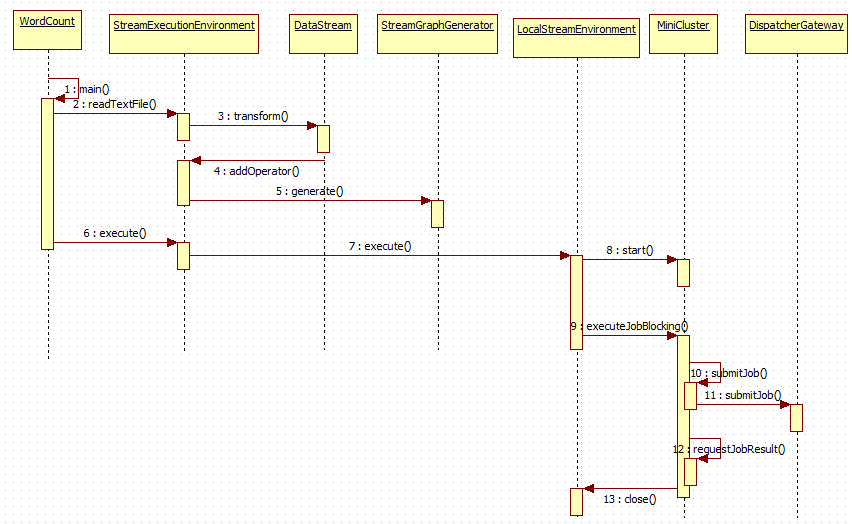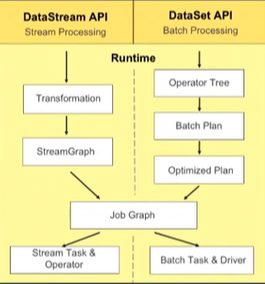从flink-example分析flink组件(3)WordCount 流式实战及源码分析
前面介绍了批量处理的WorkCount是如何执行的
<从flink-example分析flink组件(1)WordCount batch实战及源码分析>
<从flink-example分析flink组件(2)WordCount batch实战及源码分析----flink如何在本地执行的?>
这篇从WordCount的流式处理开始
/**
* Implements the "WordCount" program that computes a simple word occurrence
* histogram over text files in a streaming fashion.
*
* <p>The input is a plain text file with lines separated by newline characters.
*
* <p>Usage: <code>WordCount --input <path> --output <path></code><br>
* If no parameters are provided, the program is run with default data from
* {@link WordCountData}.
*
* <p>This example shows how to:
* <ul>
* <li>write a simple Flink Streaming program,
* <li>use tuple data types,
* <li>write and use user-defined functions.
* </ul>
*/
public class WordCount { // *************************************************************************
// PROGRAM
// ************************************************************************* public static void main(String[] args) throws Exception { // Checking input parameters
final ParameterTool params = ParameterTool.fromArgs(args); // set up the execution environment
final StreamExecutionEnvironment env = StreamExecutionEnvironment.getExecutionEnvironment(); // make parameters available in the web interface
env.getConfig().setGlobalJobParameters(params); // get input data
DataStream<String> text;
if (params.has("input")) {
// read the text file from given input path
text = env.readTextFile(params.get("input"));
} else {
System.out.println("Executing WordCount example with default input data set.");
System.out.println("Use --input to specify file input.");
// get default test text data
text = env.fromElements(WordCountData.WORDS);
} DataStream<Tuple2<String, Integer>> counts =
// split up the lines in pairs (2-tuples) containing: (word,1)
text.flatMap(new Tokenizer())
// group by the tuple field "0" and sum up tuple field "1"
.keyBy(0).sum(1); //1 // emit result
if (params.has("output")) {
counts.writeAsText(params.get("output"));
} else {
System.out.println("Printing result to stdout. Use --output to specify output path.");
counts.print();
} // execute program
env.execute("Streaming WordCount");//2
} // *************************************************************************
// USER FUNCTIONS
// ************************************************************************* /**
* Implements the string tokenizer that splits sentences into words as a
* user-defined FlatMapFunction. The function takes a line (String) and
* splits it into multiple pairs in the form of "(word,1)" ({@code Tuple2<String,
* Integer>}).
*/
public static final class Tokenizer implements FlatMapFunction<String, Tuple2<String, Integer>> { @Override
public void flatMap(String value, Collector<Tuple2<String, Integer>> out) {
// normalize and split the line
String[] tokens = value.toLowerCase().split("\\W+"); // emit the pairs
for (String token : tokens) {
if (token.length() > 0) {
out.collect(new Tuple2<>(token, 1));
}
}
}
} }
整个执行流程如下图所示:

第1~4步:main方法读取文件,增加算子
private <OUT> DataStreamSource<OUT> createFileInput(FileInputFormat<OUT> inputFormat,
TypeInformation<OUT> typeInfo,
String sourceName,
FileProcessingMode monitoringMode,
long interval) { Preconditions.checkNotNull(inputFormat, "Unspecified file input format.");
Preconditions.checkNotNull(typeInfo, "Unspecified output type information.");
Preconditions.checkNotNull(sourceName, "Unspecified name for the source.");
Preconditions.checkNotNull(monitoringMode, "Unspecified monitoring mode."); Preconditions.checkArgument(monitoringMode.equals(FileProcessingMode.PROCESS_ONCE) ||
interval >= ContinuousFileMonitoringFunction.MIN_MONITORING_INTERVAL,
"The path monitoring interval cannot be less than " +
ContinuousFileMonitoringFunction.MIN_MONITORING_INTERVAL + " ms."); ContinuousFileMonitoringFunction<OUT> monitoringFunction =
new ContinuousFileMonitoringFunction<>(inputFormat, monitoringMode, getParallelism(), interval); ContinuousFileReaderOperator<OUT> reader =
new ContinuousFileReaderOperator<>(inputFormat); SingleOutputStreamOperator<OUT> source = addSource(monitoringFunction, sourceName)
.transform("Split Reader: " + sourceName, typeInfo, reader); //1 return new DataStreamSource<>(source);
}
增加算子的方法,当调用execute方法时,此时增加的算子会被执行。
/**
* Adds an operator to the list of operators that should be executed when calling
* {@link #execute}.
*
* <p>When calling {@link #execute()} only the operators that where previously added to the list
* are executed.
*
* <p>This is not meant to be used by users. The API methods that create operators must call
* this method.
*/
@Internal
public void addOperator(StreamTransformation<?> transformation) {
Preconditions.checkNotNull(transformation, "transformation must not be null.");
this.transformations.add(transformation);
}
第5步:产生StreamGraph,从而可以得到JobGraph,即将Stream程序转换成JobGraph
// transform the streaming program into a JobGraph
StreamGraph streamGraph = getStreamGraph();
streamGraph.setJobName(jobName); JobGraph jobGraph = streamGraph.getJobGraph();
jobGraph.setAllowQueuedScheduling(true);
第6~8步启动MiniCluster,为执行job做准备
/**
* Starts the mini cluster, based on the configured properties.
*
* @throws Exception This method passes on any exception that occurs during the startup of
* the mini cluster.
*/
public void start() throws Exception {
synchronized (lock) {
checkState(!running, "MiniCluster is already running"); LOG.info("Starting Flink Mini Cluster");
LOG.debug("Using configuration {}", miniClusterConfiguration); final Configuration configuration = miniClusterConfiguration.getConfiguration();
final boolean useSingleRpcService = miniClusterConfiguration.getRpcServiceSharing() == RpcServiceSharing.SHARED; try {
initializeIOFormatClasses(configuration); LOG.info("Starting Metrics Registry");
metricRegistry = createMetricRegistry(configuration); // bring up all the RPC services
LOG.info("Starting RPC Service(s)"); AkkaRpcServiceConfiguration akkaRpcServiceConfig = AkkaRpcServiceConfiguration.fromConfiguration(configuration); final RpcServiceFactory dispatcherResourceManagreComponentRpcServiceFactory; if (useSingleRpcService) {
// we always need the 'commonRpcService' for auxiliary calls
commonRpcService = createRpcService(akkaRpcServiceConfig, false, null);
final CommonRpcServiceFactory commonRpcServiceFactory = new CommonRpcServiceFactory(commonRpcService);
taskManagerRpcServiceFactory = commonRpcServiceFactory;
dispatcherResourceManagreComponentRpcServiceFactory = commonRpcServiceFactory;
} else {
// we always need the 'commonRpcService' for auxiliary calls
commonRpcService = createRpcService(akkaRpcServiceConfig, true, null); // start a new service per component, possibly with custom bind addresses
final String jobManagerBindAddress = miniClusterConfiguration.getJobManagerBindAddress();
final String taskManagerBindAddress = miniClusterConfiguration.getTaskManagerBindAddress(); dispatcherResourceManagreComponentRpcServiceFactory = new DedicatedRpcServiceFactory(akkaRpcServiceConfig, jobManagerBindAddress);
taskManagerRpcServiceFactory = new DedicatedRpcServiceFactory(akkaRpcServiceConfig, taskManagerBindAddress);
} RpcService metricQueryServiceRpcService = MetricUtils.startMetricsRpcService(
configuration,
commonRpcService.getAddress());
metricRegistry.startQueryService(metricQueryServiceRpcService, null); ioExecutor = Executors.newFixedThreadPool(
Hardware.getNumberCPUCores(),
new ExecutorThreadFactory("mini-cluster-io"));
haServices = createHighAvailabilityServices(configuration, ioExecutor); blobServer = new BlobServer(configuration, haServices.createBlobStore());
blobServer.start(); heartbeatServices = HeartbeatServices.fromConfiguration(configuration); blobCacheService = new BlobCacheService(
configuration, haServices.createBlobStore(), new InetSocketAddress(InetAddress.getLocalHost(), blobServer.getPort())
); startTaskManagers(); MetricQueryServiceRetriever metricQueryServiceRetriever = new RpcMetricQueryServiceRetriever(metricRegistry.getMetricQueryServiceRpcService()); dispatcherResourceManagerComponents.addAll(createDispatcherResourceManagerComponents(
configuration,
dispatcherResourceManagreComponentRpcServiceFactory,
haServices,
blobServer,
heartbeatServices,
metricRegistry,
metricQueryServiceRetriever,
new ShutDownFatalErrorHandler()
)); resourceManagerLeaderRetriever = haServices.getResourceManagerLeaderRetriever();
dispatcherLeaderRetriever = haServices.getDispatcherLeaderRetriever();
webMonitorLeaderRetrievalService = haServices.getWebMonitorLeaderRetriever(); dispatcherGatewayRetriever = new RpcGatewayRetriever<>(
commonRpcService,
DispatcherGateway.class,
DispatcherId::fromUuid,
20,
Time.milliseconds(20L));
resourceManagerGatewayRetriever = new RpcGatewayRetriever<>(
commonRpcService,
ResourceManagerGateway.class,
ResourceManagerId::fromUuid,
20,
Time.milliseconds(20L));
webMonitorLeaderRetriever = new LeaderRetriever(); resourceManagerLeaderRetriever.start(resourceManagerGatewayRetriever);
dispatcherLeaderRetriever.start(dispatcherGatewayRetriever);
webMonitorLeaderRetrievalService.start(webMonitorLeaderRetriever);
}
catch (Exception e) {
// cleanup everything
try {
close();
} catch (Exception ee) {
e.addSuppressed(ee);
}
throw e;
} // create a new termination future
terminationFuture = new CompletableFuture<>(); // now officially mark this as running
running = true; LOG.info("Flink Mini Cluster started successfully");
}
}
第9~12步 执行job
/**
* This method runs a job in blocking mode. The method returns only after the job
* completed successfully, or after it failed terminally.
*
* @param job The Flink job to execute
* @return The result of the job execution
*
* @throws JobExecutionException Thrown if anything went amiss during initial job launch,
* or if the job terminally failed.
*/
@Override
public JobExecutionResult executeJobBlocking(JobGraph job) throws JobExecutionException, InterruptedException {
checkNotNull(job, "job is null"); final CompletableFuture<JobSubmissionResult> submissionFuture = submitJob(job); final CompletableFuture<JobResult> jobResultFuture = submissionFuture.thenCompose(
(JobSubmissionResult ignored) -> requestJobResult(job.getJobID())); final JobResult jobResult; try {
jobResult = jobResultFuture.get();
} catch (ExecutionException e) {
throw new JobExecutionException(job.getJobID(), "Could not retrieve JobResult.", ExceptionUtils.stripExecutionException(e));
} try {
return jobResult.toJobExecutionResult(Thread.currentThread().getContextClassLoader());
} catch (IOException | ClassNotFoundException e) {
throw new JobExecutionException(job.getJobID(), e);
}
}
先上传jar包文件,此时需要DispatcherGateway来执行上转任务,异步等待结果执行完毕
总结:
batch和stream的执行流程很相似,又有不同。
不同:Stream传递的是DataStream,Batch传递的是DataSet
相同:都转换成JobGraph执行

从flink-example分析flink组件(3)WordCount 流式实战及源码分析的更多相关文章
- SpringCloudGateway微服务网关实战与源码分析 - 中
实战 路由过滤器工厂 路由过滤器允许以某种方式修改传入的HTTP请求或传出的HTTP响应.路由过滤器的作用域是特定的路由.SpringCloud Gateway包括许多内置的GatewayFilter ...
- Vue3中的响应式对象Reactive源码分析
Vue3中的响应式对象Reactive源码分析 ReactiveEffect.js 中的 trackEffects函数 及 ReactiveEffect类 在Ref随笔中已经介绍,在本文中不做赘述 本 ...
- Flink sql 之AsyncIO与LookupJoin的几个疑问 (源码分析)
本文源码基于flink 1.14 被同事问到几个关于AsyncIO和lookUp维表的问题所以翻了下源码,从源码的角度解惑这几个问题 对于AsyncIO不了解的可以看看之前写的这篇 <Flin ...
- bootstrap_栅格系统_响应式工具_源码分析
-----------------------------------------------------------------------------margin 为负 使盒子重叠 等高 等高 ...
- Netty源码分析 (十二)----- 心跳服务之 IdleStateHandler 源码分析
什么是心跳机制? 心跳说的是在客户端和服务端在互相建立ESTABLISH状态的时候,如何通过发送一个最简单的包来保持连接的存活,还有监控另一边服务的可用性等. 心跳包的作用 保活Q:为什么说心跳机制能 ...
- 从flink-example分析flink组件(1)WordCount batch实战及源码分析
上一章<windows下flink示例程序的执行> 简单介绍了一下flink在windows下如何通过flink-webui运行已经打包完成的示例程序(jar),那么我们为什么要使用fli ...
- SpringCloudAlibaba注册中心与配置中心之利器Nacos实战与源码分析(上)
不断踩坑并解决问题是每个程序员进阶到资深的必要经历并以此获得满足感,而不断阅读开源项目源码和总结思想是每个架构师成长最佳途径.本篇拉开SpringCloud Alibaba最新版本实战和原理序幕,以工 ...
- SpringCloudAlibaba分布式流量控制组件Sentinel实战与源码分析(上)
概述 定义 Sentinel官网地址 https://sentinelguard.io/zh-cn/index.html 最新版本v1.8.4 Sentinel官网文档地址 https://senti ...
- SpringCloud Gateway微服务网关实战与源码分析-上
概述 定义 Spring Cloud Gateway 官网地址 https://spring.io/projects/spring-cloud-gateway/ 最新版本3.1.3 Spring Cl ...
随机推荐
- 查看哪些redis命令拖慢了redis
Redis提供了一个下面这样的命令统计工具: 127.0.0.1:6379> INFO commandstats # Commandstatscmdstat_get:calls=11352126 ...
- spring 5.x 系列第20篇 ——spring简单邮件、附件邮件、内嵌资源邮件、模板邮件发送 (代码配置方式)
源码Gitub地址:https://github.com/heibaiying/spring-samples-for-all 一.说明 1.1 项目结构说明 邮件发送配置类为com.heibaiyin ...
- Java:HashMap原理与设计缘由
前言 Java中使用最多的数据结构基本就是ArrayList和HashMap,HashMap的原理也常常出现在各种面试题中,本文就HashMap的设计与设计缘由作出一一讲解,并解答面试常见的一些问题. ...
- ASP.NET第一次访问慢的解决方法(MVC,Web Api)
问题现象 访问asp.net web项目的时候,第一次访问比较慢,当闲置一段时间后,再次访问还是会非常慢. 问题原因 这是IIS回收造成的,再次访问的时候会初始化操作,初始化需要耗费时间,所以访问会比 ...
- Python 爬虫从入门到进阶之路(十六)
之前的文章我们介绍了几种可以爬取网站信息的模块,并根据这些模块爬取了<糗事百科>的糗百内容,本章我们来看一下用于专门爬取网站信息的框架 Scrapy. Scrapy是用纯Python实现一 ...
- ajax 前端发含有列表的数据
在前端页面也可以给后端发送一个包含列表的数据 html <body> <h3>index页面 </h3> <input type="text&quo ...
- 利用consul在spring boot中实现最简单的分布式锁
因为在项目实际过程中所采用的是微服务架构,考虑到承载量基本每个相同业务的服务都是多节点部署,所以针对某些资源的访问就不得不用到用到分布式锁了. 这里列举一个最简单的场景,假如有一个智能售货机,由于机器 ...
- centos下安装色彩scrapy
一.安装Python2.7.6 更新CentOS lib库文件 yum -y update 安装开发工具包 yum groupinstall -y development 安装扩展包 yum inst ...
- Centos7:yum安装MySQL5.7后如何设置root密码
Centos下安装软件的方式很简单,只需要通过yum install xxx命令即可.第一步当然检查是否有mysql的yum源,命令:yum list|grep mysql-community[主要还 ...
- java操作mongo
语法正确时,字段不匹配时,Mongo并不会抛出异常,这在语句调试时需多加注意. mongo自身的时间存储格式与java中的并不是完全匹配,Mongo采用UTC格式,而java中一般为GMT格式,有个时 ...
